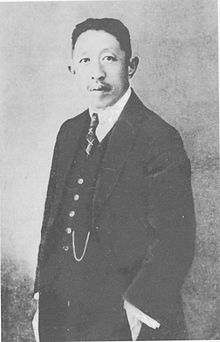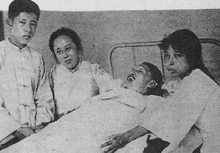Liao Zhongkai
Liao Zhongkai ( Chinese 廖仲愷 / 廖仲恺 , Pinyin Liào Zhòngkǎi , W.-G. Liao Chung-k'ai , Jyutping Liu 6 Zung 1 hoi 2 , Yale Liuh Juhng-hói ; born April 23, 1877 in San Francisco , United States ; † August 20, 1925 in Guangzhou , Republic of China ) was a Chinese politician and instrumental in the formation of the First United Front between the Kuomintang and the Communist Party of China in the 1920s.
Early life
Liao was born in San Francisco in 1877 as one of 24 children of the Christian Chinese banker Liao Zhubin . His father, who had five wives, was working there for the Hong Kong and Shanghai Bank at the time . At the age of 16, the son went to Hong Kong in 1893 and studied at Queen's College there from 1896 . The following year he married He Xiangning. In January 1903 he went to study political science at the Japanese Waseda University , from where he moved to the University of Tokyo in 1907, where he studied economics as well as political science. During this time he received financial support from his wife's family, who had accompanied him to Japan and attended an art school in Tokyo.
Political career
In Tokyo, Liao, who was increasingly enthusiastic about the anti-imperialist movements in China, met the influential revolutionary Sun Yat-sen in the summer of 1903 . Immediately after its establishment, he joined the revolutionary collecting movement Tongmenghui . Since Liao and He did not appear to be suspected by the Japanese police of being close to the Tongmenghui, their joint home became an important meeting place for this group. In 1909 he went back to China to either carry out an assignment for Sun Yat-sen or to work for the provincial administration of Jilin , where he was when the Xinhai Revolution broke out in October 1910. In the course of the revolution, the southern province of Guangdong declared itself independent as the Republic of China in 1911 and Hu Hanmin offered Liao the post of head of the financial administration due to his academic background, which he accepted and brought his family from Japan to Guangzhou . The increasing power of the leader of the Beiyang army , which is still strongly monarchist , Yuan Shikai , who was considering a restoration of imperial rule, and the failure of a renewed attempted coup by the republican forces led Liao and his family to join other revolutionaries such as Sun and Hu fled to Japan. In 1916 he returned to China again and, after Yuan's death, negotiated with Hu Hanmin with the Beiyang government in Beijing about the possibility of a unification of the country under democratic leadership. After canceling this, they went back to Guangzhou, where Liao took over the financial management again. In June 1922, warlord Chen Jiongming , who was in power in Guangdong at the time, tried to overthrow Sun Yat-sen as President of the Republic of China and arrested Liao. When he was released two months later, he fled to Hong Kong. After a stay in Shanghai , he traveled to Japan again and negotiated there with the Soviet ambassador, who on behalf of the Comintern promised to support the revolutionary Guomindang . This enabled Liao to establish himself as one of the leading figures of the left-wing revolutionary wing of the party. After Chen's defeat in March 1923, he returned to Guangzhou. Between May 1923 and February 1924, Liao assumed the role of civil governor of Guangdong Province. Although he was now a close confidante of Sun Yat-sen, he opposed him in November 1923, when he was the only influential Guomindang politician to support a land and labor reform proposed by the professional revolutionary Mikhail Borodin , which was ultimately not implemented. He was also a strong advocate of the establishment of a military academy that would professionalize the military and make Guomindang more independent from mercenaries and warlords. After Chiang Kai-shek's resignation from the leadership of the academy, Liao directed efforts to finally open the Whampoa Military Academy in early 1924 .
During the First United Front between the nationalist Kuomintang and the Communist Party, he was a member of the Central Executive Committee of the Kuomintang and was tasked by Sun with reforming the party based on Marxist-Leninist structures. At the same time Liao took over the department for workers, later that for farmers. After Sun Yat-sen's death in March 1925, the left-wing revolutionary Liao was able to assert himself alongside Wang Jingwei and the conservative Hu Hanmin as one of three strong men in the Central Executive Committee of the Kuomintang. When a national government against the Beijing-based Beiyang government was proclaimed in Guangzhou on July 1, Liao became one of three members of the government's political council and finance minister alongside Wang and General Xu Chongzhi . Through his strongly left-wing positions, which he justified by continuing Sun's policies - including close cooperation with the Soviet Union and the Communist Party integrated into the Kuomintang - he incurred the anger of conservative and right-wing party members.
assassination
On August 20, 1925, five assassins ambushed Liao in front of an executive committee meeting in Guangzhou . When he got out of his car, they shot him down with Mauser C96 pistols , and he died several hours later. In his diary, Chiang Kai-shek initially suspected British clients behind the murder and in a speech at Liao's funeral, blamed him on imperialist and reactionary forces. A commission of inquiry set up on the recommendation of Mikhail Borodin consisted of Wang Jingwei, Chiang Kai-shek and Xu Chongzhi. She identified a cousin of Hu Hanmin as one of the prime suspects and uncovered a plan by conservative Kuomintang elements to eliminate supporters of the far-left wing in Guangzhou with the support of the party-loyal forces in Guangdong. Hu Hanmin was subsequently expelled from the Central Executive Committee and several high-ranking officers under Xu Chongzhi were executed. Xu himself could not be linked to the murder, but had to accept a month-long exile in Shanghai at the end of September, as connections to Chen Jiongming were verified. Hu Hanmin was sent to Moscow as the Kuomintang's ambassador to the Comintern. Lin Sen and Zhou Lu , who were also suspects during the investigation , were sent to the Beiyang government as diplomatic agents. These purges left behind a strengthened Wang Jingwei and an ascended Chiang Kai-shek in the party leadership, both close to the left wing wing at the time.
Liao and his wife, He Xiangning, had a daughter, Liao Mengxing, and a son, later communist politician Liao Chengzhi . His niece is the Chinese-American politician Anna Chennault .
Remarks
- ^ Kurt Werner Radtke and Chengzhi Liao: China's Relations with Japan 1945–83. The Role on Liao Chengzhi. 1990, p. 23.
- ^ A b Kurt Werner Radtke and Chengzhi Liao: China's Relations with Japan 1945–83. The Role on Liao Chengzhi. 1990, p. 25.
- ^ Kurt Werner Radtke and Chengzhi Liao: China's Relations with Japan 1945–83. The Role on Liao Chengzhi. 1990, p. 26.
- ^ Kurt Werner Radtke and Chengzhi Liao: China's Relations with Japan 1945–83. The Role on Liao Chengzhi. 1990, p. 30.
- ^ Kurt Werner Radtke and Chengzhi Liao: China's Relations with Japan 1945–83. The Role on Liao Chengzhi. 1990, pp. 31-32.
- ↑ Dieter Kuhn: The Republic of China from 1912 to 1937: Draft for a political history of events. 2007, p. 288.
- ↑ Dieter Kuhn: The Republic of China from 1912 to 1937: Draft for a political history of events. 2007, p. 292.
- ↑ Jay Taylor: The Generalissimo - Chiang Kai-Shek and the Struggle for Modern China. 2009, p. 44.
- ↑ Jay Taylor: The Generalissimo - Chiang Kai-Shek and the Struggle for Modern China. 2009, p. 50.
- ↑ Jonathan Fenby: Generalissimo - Chiang Kai-shek and the China he lost. 2003, p. 84.
- ↑ Jay Taylor: The Generalissimo - Chiang Kai-Shek and the Struggle for Modern China. 2009, pp. 51-52.
- ↑ Dieter Kuhn: The Republic of China from 1912 to 1937: Draft for a political history of events. 2007, pp. 330-331.
literature
- Jonathan Fenby: Generalissimo - Chiang Kai-shek and the China he lost. The Free Press, London 2003, ISBN 978-0-7432-3145-9 .
- Mayumi Itoh: Pioneers of Sino-Japanese Relations. Liao and Takasaki. Palgrave-MacMillan, New York 2012, ISBN 978-1-137-02734-4 .
- Dieter Kuhn: The Republic of China from 1912 to 1937: Draft for a political event history. 3. Edition. Würzburger Sinologische Schriften, Heidelberg 2007, ISBN 3-927943-25-8 .
- Kurt Werner Radtke and Chengzhi Liao: China's Relations with Japan 1945–83. The Role on Liao Chengzhi. Manchester University Press, Manchester 1990, ISBN 978-0-7190-2795-6 .
- Jay Taylor: The Generalissimo - Chiang Kai-Shek and the Struggle for Modern China. 1st edition. Harvard University Press, Cambridge 2009, ISBN 978-0-674-03338-2 .
Web links
| personal data | |
|---|---|
| SURNAME | Liao, Zhongkai |
| ALTERNATIVE NAMES | 廖仲愷 (Chinese); 廖仲恺 (Chinese); Liào Zhòngkǎi (Pinyin Romanization); Liao Chung-k'ai (Wade Giles Romanization); Liuh Juhng-hói (Yale Romanization) |
| BRIEF DESCRIPTION | Chinese politician |
| DATE OF BIRTH | April 23, 1877 |
| PLACE OF BIRTH | San Francisco , United States |
| DATE OF DEATH | August 20, 1925 |
| Place of death | Guangzhou , Republic of China |

